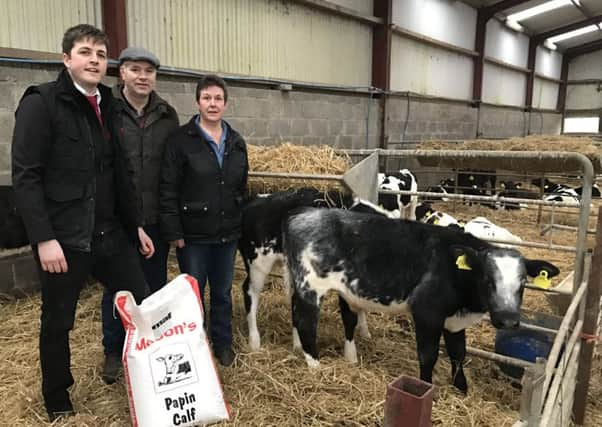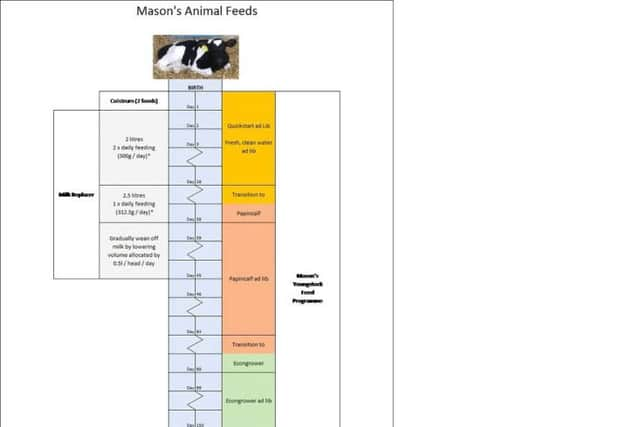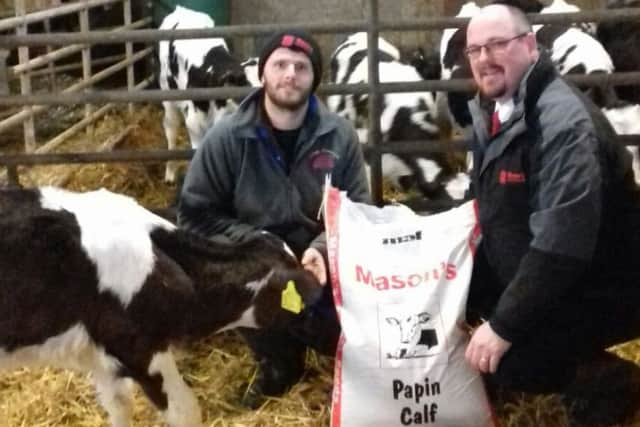Life after Colostrum '“ A new approach to superior calf rearing


Whilst this is not for in depth discussion in the current article, it is widely accepted that the newborn calf must absorb immunoglobulins from colostrum as quickly as possible postpartum to ensure adequate passive immunity is established to resist disease in those critical first few months of life.
However, despite a farmer’s dedication to colostrum management, calf morbidity and mortality still represents a significant cost to the NI dairy and beef industry both in terms of veterinary costs associated with treating sick animals plus the losses associated with poor performance and mortality. The team at Mason’s Animal Feeds feel that not enough emphasis is placed on managing the calf after colostrum and they have developed a detailed programme to address this very issue. Their programme focusses on critical developmental time points during early life that are crucial for the future success of your dairy cow or beef animal. This programme embraces a new era of ruminant nutrition, whereby bespoke rations are formulated to establish synergy between balanced nutritional inputs, the immune system and the animal’s internal environment to deliver these three main outcomes:
Advertisement
Advertisement
q Create a positive energy balance whereby internal programming delivers maximum growth from an early age


q Maintenance of a high level of immune competence to maximise the animal’s ability to fight disease
q Reduce pathogen load within the gut environment to ensure maximum absorption of nutrients at all times.
To accomplish these outcomes Masons have adopted a unique approach to calf rearing; one that is focussed on gut health and rumen development. Contrary to conventional rearing systems, this approach is based on a low milk replacer intake and early rumen development driven by their very specific feeding programme. The critical and interlinked deliverables associated within this programme are: avoiding negative energy balance, optimising gut health and fast-tracking rumen development. Uniquely, their programme addresses all of these deliverables from day two of life.
Advertisement
Advertisement
Mason’s milk is specifically designed to minimise fat mobilisation in the young calf and coupled with ad lib access to Quickstart, it delivers a high nutrient intake without compromising gut integrity. Maintaining the stability of gut microflora and avoiding gut wall inflammation ensures optimum nutrient absorption. It is the latter that forms the rationale behind a low milk replacer intake.


It is inevitable, no matter how clean your system is, that feeding high volumes of milk replacer will inadvertently increase the number of pathogens entering the gastrointestinal tract. Due to the calf having a very immature immune system at this young age, rapid pathogenic proliferation in the gut can result causing inflammation of the gut wall and suppressing nutrient absorption.
To emphasise the importance of this, it is important to remember that when a calf is scouring due to pathogens, no nutrients are being absorbed and before this clinical stage is reached there could be a prolonged period of supressed nutrient absorption due to varying levels of gut wall inflammation. Mason’s Quickstart is uniquely formulated to deliver highly digestible energy and protein to the calf and to protect the gut wall from pathogen attack. Quickstart also promotes early rumen development which is essential to complement Masons’ early weaning approach (under seven weeks of age, Figure 1).
Once the calf is eating approximately 1kg of Quickstart (around Day 28 of life, Figure 1), Masons then transition to stage two; Papincalf. Papincalf is again specifically designed to offer high levels of gut protection in these early days of life. Furthermore, it starts to focus more on rumen development and contains essential rumen protection properties. Calves stay on this to approximately 125kgs and then transition to Stage 3; Econgrower. Econgrower is designed to optimise growth during this efficient period of the animal’s life and has particular focus on rumen modulation and protection. Rumen modulation is a unique approach designed to control volatile fatty acid production in the rumen which reduces the risk of SARA and ensures rumen function is optimised. Optimising rumen function and maintaining microbial stability will deliver higher feed efficiencies and ensure optimal growth. Please note, all transitions between stages should be performed carefully and over a minimum of two weeks to ensure rumen function is not compromised (Figure 1). All these products contain the appropriate mineral and vitamins, yeasts and myctoxin absorbers as well as the uniquely designed ingredients which are only available in these products.
Advertisement
Advertisement
As previously stated, the aim of this system is to optimise energy balance, maximise immune competence and subsequently deliver high growth rates. Compared to a conventional system, this system delivers over 25% more MJ of energy per day to the calf during the first 12 weeks of life (over 600MJ in total during this time period). Put simply, this ensures that the calf is on a rapidly rising plane of nutrition from day one with no checks in growth. This high energy intake promotes the up-regulation of natural growth hormones delivering rapid growth rates in early life, a time in which the animal is most efficient.


The results to date on farm have been exceptional; growth rates are averaging over 1.15kg/head/day in the first 12 weeks of life with exceptional growth rates in last month of this period due to early life programming. Furthermore, disease levels are dramatically reduced on farm and because this feeding system is designed to promote gut health and immune function, Masons have virtually eliminated calf scour as well as minimising respiratory disease when farm environmental conditions are optimal. However, it is important to emphasise that if pathogen load exceeds immune competence, disease will result. There are a number of other managerial approaches on farm to complement this feeding system which can help avoid this undesirable imbalance between pathogen load and immune competence. The most important of these are providing dry clean beds, allowing adequate space allowance and optimising ventilation. Masons are happy to discuss these with you on a one-to-one basis.
Figure 1 outlines the programme and you will notice that Masons treat all calves the same until five months of age and this is very deliberate. Irrespective of the calf’s destiny, this programme is designed to minimise disease and mortality in early life and promote an internal environment that optimises production, delivering an animal that is fit for purpose for the future. After this point Masons then diverge to rations that are appropriate for the production system which they will expand on in the future.
Please do not hesitate to contact Mason’s Animal Feeds for further information; tel; 02838371415, email; [email protected]